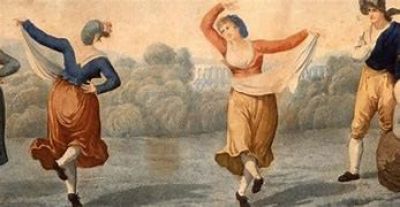The dances the Saltarello, the Tarantella and the Taranta are traditional dances that belong to southern Italy. These three dances are similar in the fact that the music used is rhythmic. The music is cadenced and constant in a harmonious and rhythmic way so that the dance steps can be repeated.
The saltarello dance can be traced to ancient Rome. It is also known as ballerella, ballarello, e saltarella. Some writers believe that during the Renaissance, the saltarello was the dance only for aristocrats and later it became a dance for the populace. Other writers, however, think that this dance was actually birthed from the populace before it became part of the aristocratic societies. This dance seems to have been opposed by the Church because it had erotic allusions. Therefore, the Church tried to limit its popularity and its spread. The instruments used for this dance depend on where it was being performed geographically. In the past, in the southeast of Italy, bagpipes were used. Today, though, the organ is substituted for bagpipes. Other musical instruments that are used are: the mandolin, the colascione lute (local to certain areas), or the tambourine. These instruments were played together with a guitar, a mini guitar, and a harmonica.
The Tarantella comes from the term Taranta, a name still said in the Puglia region of Italy. It is a dialect word that refers to an ancient dance named after the Lycosa tarentula, which is a poisonous spider that is commonly found in southern Europe especially around Taranto. The Taranto, therefore, is a dance that originates from the healing after this tarantula bite. In the past, people used to gather around the person that was bitten by this spider. Music used to be played for hours and hours until the person who was bitten, in a state of semi-consciousness, would begin to squirm and thrash until he/she was freed from the spider bite’s effects on the body. The musical instruments used for this dance were very large tambourines, the violin, and the cello.
By using the term Tarantella, we want to group together all the dances that spread through southern Italy. The Tarantella represents the symbol of the dance used during the kingdom of two Sicilys. There are different types of a Tarantella. The Neapolitan Tarantella is one example, from which the Sorrento version was then derived during the 18th century. There are some legends that say that the sirens used the movements from the Tarantella dance when they cast a spell on Ulysses. Another Tarantella version called Montemarano is danced during Carnivale. Other versions are from Sicily, Calabria, and Abruzzo. Although there are different versions, one commonality between them all is that it is danced in couples. There are also a variety of musical instruments that are played for this dance. The Neapolitan version uses mandolins. Castanets, tambourines, and accordions are also used in other versions.
Il ballo detto del Saltarello insieme alla Tarantella e la Taranta sono tutti balli tradizionali che appartengono alla tradizione dell’Italia del sud. Una cosa che accomuna questi balli è il ritmo della musica utilizzata. Essa, infatti, è cadenzale e costante per poter effettuare in modo armonico e ritmico gli stessi passi ripetuti.
Il ballo del saltarello ha le sue origini nell’antica Roma. Alcuni scritti ritengono che nel periodo Rinascimentale il saltarello veniva utilizzato come danza negli ambienti aristocratici, solo più tardi si impose anche negli ambienti popolari. Altri scritti ritengono invece, che il saltarello (noto anche come ballarella, ballarello e saltarella) sia nato prima negli ambienti popolari, solo in seguito sia stato ripreso dagli ambienti aristocratici. Pare che questa danza sia stata molto osteggiata dalla Chiesa perché era rappresentata con allusioni erotiche, quindi, la Chiesa cercava di limitarne la diffusione. Gli strumenti utilizzati per il ballo del saltarello dipendono dalle zone geografiche. La zampogna in passato era lo strumento con il quale veniva suonato questo ballo nella zona del sud est dell’Italia. Oggi l’organetto ha sostituito l’uso della zampogna. Altri strumenti musicali che si usano sono: Il mandolino, il calascione nella zona laziale, il tamburello, insieme alla chitarra o chitarrina e l’armonica.
La Tarantella deriva dal termine Taranta, nome ancora usato nella regione pugliese per descrivere questo antico ballo, parola dialettale per rappresentare la Lycosa tarentula, un ragno velenoso diffuso in Europa meridionale, in particolare nelle zone intorno a Taranto. La Taranta, quindi, è una danza che ha origine come terapia contro il morso della tarantola. In passato, tutte le persone si radunavano intorno alla persona morsa dal ragno e la musica veniva suonata per ore fino a quando la persona morsa, in uno stato di semi incoscienza, iniziava a dimenarsi e dibattersi fino a liberarsi dagli effetti del morso del ragno. Gli strumenti utilizzati per suonare la musica usata per la Taranta, sono dei grandi tamburelli, il violino e il violoncello.
Con il termine Tarantella, si vogliono raggruppare tutti quei balli che si sono diffusi nell’Italia meridionale. La Tarantella rappresenta il simbolo della danza nel regno delle due Sicilie. Ci sono diversi tipi di Tarantella: L a Tarantella napoletana: Di cui quella sorrentina nasce nel XVIII sec. Alcune leggende dicono che le sirene abbiano usato le movenze della tarantella per ammaliare Ulisse. La Tarantella di Montemarano che si balla durante il Carnevale. Altre Tarantelle sono: Quella siciliana, quella calabrese e quella abruzzese. Tutte queste tarantelle hanno in comune il fatto che si ballano in coppia e che gli strumenti che si usano variano dai mandolini in quella napoletana alle nacchere, ai tamburelli e alle fisarmoniche.
https://www.lagazzettaitaliana.com/history-culture/10099-i-balli-tradizionali-italiani-il-saltarello-la-tarantella-e-la-taranta#sigProId6ca7eb78f6




